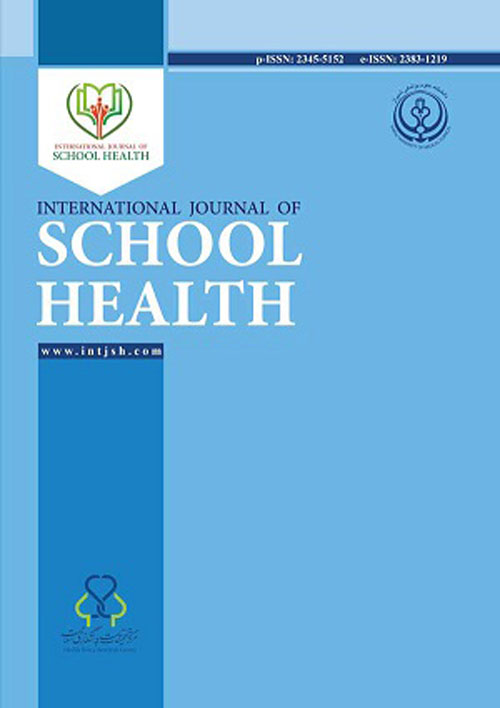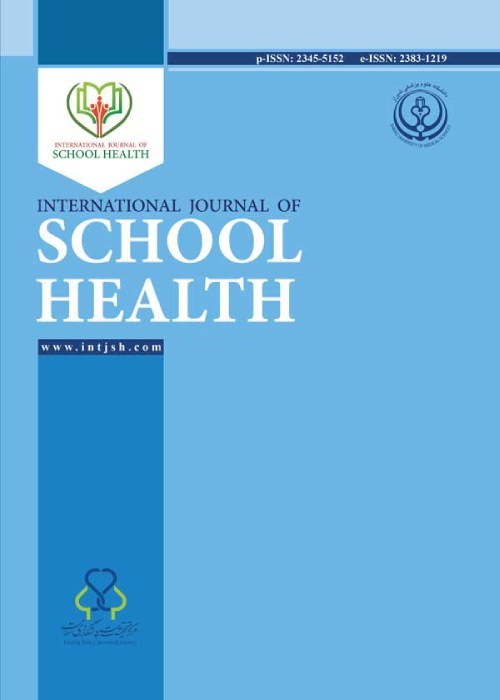فهرست مطالب

International Journal of School Health
Volume:3 Issue: 2, Spring 2016
- تاریخ انتشار: 1395/02/30
- تعداد عناوین: 7
-
-
Page 1BackgroundIn facing with difficult situations some people cannot stand and give up, while others who are called resilient stand and solve their problems..ObjectivesThis study is a semi-experimental research with pre-test and post-test conducted to investigate the effectiveness of training the components of Redecision therapy on the increase of resilience among female Tehran students..
Patients andMethodsThe participants of this study comprised 20 students from third grade high school with low scores in CD-RISC selected by random cluster sampling and randomly assigned into two experimental and control groups of 10. Sessions of Redecision therapy were implemented for experimental group and the control group received no interventions. We used Connor and Davidson resilience scale or CD-RISC (2003). The reliability (the Cronbachs α) and factor analytic structure of the scale were evaluated..ResultsThe reliability obtained was 0.85. The results showed a significance difference between the control group and experimental group (PConclusionsRedecision therapy help people to identify negative parental messages and make new decisions; we can expect this training improve the resilience among students..Keywords: Resilience, Redecision Therapy, Transactional Analysis, Gestalt Therapy -
Page 2BackgroundThe environmental health of schools is included all activities that have a direct effect on preservation of students health and the prevention of the diseases transmission and promotion of the level of the environmental health of schools..ObjectivesThis cross-sectional study was conducted to evaluate the environmental health and safety status of public and private schools of Shiraz city, Iran, in 2014..Materials And MethodsThe total number of schools was included 1055 public schools and 490 private schools. The multistage random stratification sampling was performed and samples of 752 schools were met. In order to collect data, a list based on form of regulation of school environmental health was used and 74 questions were selected and the data were analyzed using the SPSS software version 19..ResultsThe results showed that there was no proper health buffet in 43% of the public schools and 65% of the private schools. Also, only 17% of total schools had a hygiene educator. In terms of availability to equipment and tools, 90% of the public schools and 96% of the private schools had proper conditions. In terms of security and safety, 71% of the public schools and 73% of the private schools had proper conditions..ConclusionsWith regard to these findings, it can be concluded that the separately investigation of environmental health status and security of schools at all four areas is necessary..Keywords: Environment Health, Safety, Public, Private Schools, Shiraz
-
The Prediction of Depression by the Early Trauma and Maladaptive Schema in 11 - 13 Year-Old StudentsPage 3BackgroundDepressive disorder spectrum has been shown to be a significant mental health issue for school-age children. Yet little work has been done to investigate the predictive factors correlated with this early form of depression..ObjectivesThe aim of this study was to determine the predictive role of early trauma and maladaptive schema in dimensions of depression in 11 - 13 year-old students..Materials And MethodsMulti-stage random sampling was used to select 292 school-age children (201 females, 91 males) with mean age 12.33. All subjects were asked to complete childrens depression inventory (CDI), childhood trauma questionnaire (CTQ) and schemas inventory for children (SIC). The analysis of data was done using canonical correlation..ResultsStructural coefficients showed that the pattern of high scores in early trauma and maladaptive schema correlate with the pattern of high scores in depression dimensions. Therefore, the findings indicate that the combination of low early trauma and maladaptive schema can probably decrease the likelihood of depression..ConclusionsIn general, the findings of this study showed that early trauma and maladaptive schema can predict depression in children and explain a considerable variance of survival index..Keywords: Depression, Trauma, Schema, Children
-
Page 4BackgroundWho takes care of the children after school? is a question in many researches. Children may feel lonely and depressed if they open the house door and find no body in the house..ObjectivesThe study examines loneliness and depression in students who regularly care for themselves after school (latchkey students) and compared with students who enjoy the parents company .
Patients andMethodsThis study comprised 270 students, aged between 7 to 13 years in Mashhad, selected by convenience and cluster random-assignment sampling, using depression self-rating questionnaire and loneliness self-rating scale..ResultsUsing a causal-comparative research method, independent t-test results showed significant differences in loneliness (-4.32, P ≤ 0.05) and depression (-3.02, P ≤ 0.05) between latchkey and non-latchkey students. Using the Pearson correlation test, significant correlation between depression and loneliness was observed among latchkey students (r = 0.59, P ≤ 0.05). However, no significant difference between loneliness and depression was observed (r = 0.02. P ≥ 0.05) in non-latchkey students. Multiple regression analysis also showed that depression variance can be determined by gender 22% and loneliness 34% (boys and girls)..ConclusionsThe findings of this study, specifically the significant difference between latchkey and non-latchkey children, regarding feelings of loneliness and depression, carries clear message for parents. It can be concluded that mothers who spend most of their time working out of the house and deprive their children of their presence at home may cause some form of mental distress like loneliness and depression in youngsters. Moreover, gender differences affect the degree of these psychological disorders..Keywords: Loneliness, Depression, Self, care Students, Latchkey, non, Latchkey Students, Gender -
Page 5BackgroundAttachment to grandparents has been deemed important for the healthy development of adolescents..ObjectivesThis study tests three competing arguments in regard to how gender may modify adolescent attachment to grandparents in Chinese context..Materials And MethodsData used for testing hypotheses are drawn from survey responses of over 500 middle school students from Fuzhou city, China. Regression models assess the alternative hypotheses..ResultsThe results are in support of son preference claim showing greater attachment to both paternal grandfather and grandmother among boys than girls, while no gender differences are found in attachment to maternal grandparents. Further, gender differences sustain in sample containing all respondents as well as among singleton students only after controlling for grade level, parent education, familys financial status, parent divorce, co-residence with grandparents, and respondents psychological and behavioral adjustments..ConclusionsFindings are discussed in light of gender inequality embedded in the cultural tradition and family dynamics of mainland China..Keywords: Attachment, Grandparent, Gender, Middle, School Students, China
-
Page 6BackgroundIn academic settings, the goals that students pursue have a significant impact on students motivation, performance and emotions, a condition known as achievement emotion..ObjectivesThe goal of this research is to assess the effect of accomplishment goal on achievement emotion of students..
Patients andMethodsThe study comprised 380 elementary students of grades four to six. They completed self-report questionnaires tapping Achievement Goals Questionnaire (AGQ) and Achievement Emotions Questionnaire (AEQ) in the classroom during a school session. All descriptive statistics, regression and confirmatory factor analyses, were performed using SPSS 19..ResultsSimultaneous multiple regression of achievement goals on students achievement motivation showed that, each of the achievement goals predicts achievement emotions differently. The findings are fully presented in the result section..ConclusionsThe results of this study revealed that achievement goal is a significant factor in predicting achievement emotions. Actually, these results present evidence of the advantages of mastery goals and the disadvantages of performance avoidance goals..Keywords: Achievement Goal, Achievement Emotion, Students -
Page 7BackgroundAlthough college students are more likely to exhibit characteristics of eating disorders than other age groups, results are mixed as to whether college athletes are more at risk for disordered eating than non-athletes or former high school athletes..ObjectivesThe purpose of this cross-sectional study was to determine if collegiate male and female athletes are more likely to exhibit characteristics of an eating disorders compared to college males and females who participated in high school sports but did not continue playing collegiately..
Patients andMethodsA survey consisting of the eating attitude test 26 (EAT-26), the body shape questionnaire (BSQ) and three sections of the eating disorder inventory (EDI) body dissatisfaction (EDIBD), drive for thinness (EDIDFT) and the bulimia (EDIBUL) was administered to collegiate athletes (n = 107), former high school athletes (n = 152), and those who did not play sports in high school (non-athletes) (n = 31) in April and May of 2011..ResultsA comparison of collegiate athletes, high school athletes, and non-athletes resulted in ANOVA significant (P ≤ 0.05) for EAT (F = 6.145, PConclusionsThe results of this study do not support previous findings that athletes are more likely to exhibit characteristics of an eating disorder than non-athletes as athletes scored significantly lower on the EAT, EDIDFT, EDIBD, and BSQ. Although no significant difference was found between high school athletes and non-athletes, high school athletes on average scored lower on all five measures. These results reveal that more research needs to be conducted to determine if one of these groups is at a greater risk of an eating disorder than the other..Keywords: Disordered Eating, Body Satisfaction, Participation in Sports


